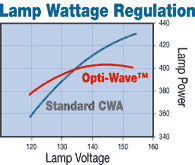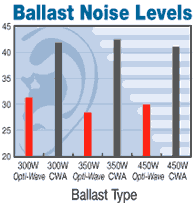| |
Open Circuit
Voltage (OCV)
The
voltage across the output terminals of ballast with no load connected
is the OCV. Lamp OCV requirements differ for the various ballast
circuit types.
Sustaining
Voltage (Vss)
Vss is the instantaneous voltage across the lamp when lamp current
crosses zero. If the voltage is not sufficient, the lamp will not
ignite on the next half cycle of current, and drop out. Adequate
Vss is needed from every ballast type, but is particularly important
for CWA ballasts. However, it is difficult to measure without sophisticated
lab equipment. ANSI standard values are determined for the condition
just following the development of a full arc discharge. This is
when the current characteristics of CWA ballasts are most likely
to cause lamp drop out. ANSI does not specify Vss for lag or HX
circuits.
AC Line Regulation
Line
regulation is the percent change in lamp wattage per percent change
of supply voltage. In the US, Canada and most of Europe, supply
voltage can be unreliable (such as a brownout or blackout); however,
normal variability is small. An exception might be an industrial
application where large electrical loads switching on and off affect
lighting circuits. Where supply voltages are steady, HX ballasts
provide the best performance at a cost comparable to CWA ballasts.
When there is a serious line voltage regulation issue, regulated
lag or electronic ballasts are preferred. Lag ballasts dominate
HID lighting in Europe, where supply voltage is regulated to ±5%.
In North America, lighting circuits wired according to the National
Electric Code typically stay within the ±5%.
back
to top
|
|
Lamp Regulation
By
definition, lamp voltage regulation is the change in lamp wattage
divided by the corresponding change in lamp voltage initially and
during life. The ANSI lamp voltage range allowed for a new (100-hour)
lamp is typically ±12%. Modern lamp manufacturing processes typically
yield metal halide lamps with a much tighter voltage range. However,
metal halide lamps typically rise between 1 and 2 V per 1000 hours.
At end of life, the metal halide lamp voltage can be more than 25%
higher than at 100 hours. With modern AC power lines regulated to
within 5%, it is more important to have tight regulation of lamp
power with respect to lamp voltage variation than supply voltage
regulation. This results in the least lamp-to-lamp color and brightness
variations.

The operating
characteristics of any ballast can be mapped in a graph of lamp
wattage vs. lamp voltage. For lag and HX ballasts, the graph is
a parabola where the peak wattage typically occurs when the lamp
voltage is about 60% of the OCV. The curve stops when the lamp voltage
reaches about 80% of the OCV. At this point, the lamp stops operating.
The graph for most CWA or constant current ballasts is relatively
straight line. HPS lamps need operating characteristics similar
to resistive and lag ballasts, a constant current characteristic
is unstable.
High pressure
sodium lamp "Trapezoids"
The HPS trapezoid is bounded by upper and lower wattage limits.
At the low watt limit, the lumens are low; at the high watt limit,
life is short. The left side of the trapezoid represents the lowest
voltage lamp a user could encounter. The right side represents the
highest voltage lamp a user should expect to operate. The sides
of the trapezoid slope because increasing power increases the voltage
of HPS lamps. Acceptable ballasts chart a path that passes through
both sides within the min. and max. wattage limits. The three ballast
curves in the graph above illustrate the effect of low, nominal,
and high line voltage.

back
to top
|
|
Minimum ambient
temperature for starting
ANSI
and IEC write lamp specifications so that lamps will start at
-30°C
(-22°F) to -40°C
(-40°F). Mercury vapor and
metal halide lamps will start at lower voltages at room temperature.
As temperatures drops below -40°C, not much happens until Xe (HPS) or Ar (metal halide and mercury vapor) starting gases condense
to the liquid state. At these temperatures (-160°C/-310°F
and lower) we are not aware of lighting opportunities.
Ballast Noise
Magnetic ballasts generate audible noise as a result of magnetically
induced mechanical stress. This may be amplified or attenuated depending
on fixture design, mounting methods and room acoustics. There are
presently no noise standards for HID ballasts. Generally,
Single Voltage Hybrid and HX
ballasts are noticeably quieter (greater than 10 dB) than CWA, CWI
or regulated lag ballasts.

back
to top
|
|

